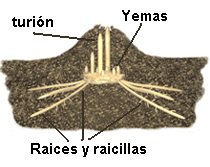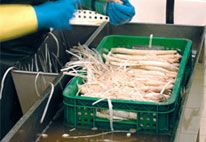The asparagus is one of the most emblematic products of Navarra, this fertile land is often referred to as the larder of Spain. On the banks of the Ribera del Ebro, with a warm Mediterranean climate and located in a landscape scattered with hills and small mountain ranges, the Autonomous regions of Navarra, Aragon, and La Rioja can be discovered. This area is where the Asparagus of Navarra is cultivated and protected by its Designation of Origin as well as many other Spanish gourmet delights from the north that I will be writing about in future posts and have already mentioned before in earlier posts such as the Cecina from Leon.
Asparagus is a very contemporary product despite its ancient origins, as proven by Egyptian paintings dating back to 3,000 years BC that show the first images of this vegetable. However, the first time they were actually mentioned was during the Roman Empire in writings by authors such as Pliny.
According to legend, the first seeds of this refined foodstuff were brought from Baghdad in the baggage of a local citizen who was obliged to leave the city and ended up settling in Cordoba. A man from Tudela, who was travelling in those parts, tasted the delicacy for the first time and asked him to spare a few seeds, sowing them on his return in the capital of the Ribera region and making asparagus one of the leading lights of Navarrese cuisine.

The Asparagus of Navarra is a perennial plant which loses its leaves and trunk during the winter, with a productive life that lasts from six to eight years. It has a very powerful root system composed of main roots which grow horizontally and from which the small secondary roots grow. From a central stump or bulb turions or asparagus grow upwards looking for light.This is the secret: to stop them reaching the light. If the "turions" or stems reach the surface, the frond is formed. On the other hand, if they are harvested before they see daylight, we have white asparagus, if not they would turn green with photosynthesis so the earth is frequently raised to form little hills so that the asparagus never sees daylight until it is ready to eat.


Asparagus is planted during February, placing it at the bottom of a furrow and covering it with sand afterwards. During the spring, the stems grow, and in this period and throughout the summer, the plant accumulates reserves in the roots to be able to sprout the following year. During the winter, the parched frond is cut, and the land is prepared.
In the second year, during March, before the plant begins to sprout again, the ridging is carried out. A ridge is a small pile of earth on the plantation line so that the sprouts reach the surface much later. This provides them with their traditional white colour and makes them much more tender and sweeter
Although the Asparagus from Navarra has traditionally been related to a canned or bottled product, in recent years, strong demand has grown for fresh white asparagus. Fresh white asparagus is available during the harvest-time, which is between April and June. The fresh white asparagus needs to be peeled and normally boiled, a simple process that allows you to enjoy their fuller flavour.
To peel them it is necessary to hold the asparagus by the tender tip and, with a kitchen knife or a vegetable peeler, it must be peeled from top to bottom, being careful not to touch the head, and turning it to homogeneously peel all of it. Lastly, the bottom part of the stalk is cut, and the asparagus is washed in cold water.
To boil them, fill in a deep pan with water and bring it to the boil. As soon as it begins boiling, add three teaspoons of salt and 1 teaspoon of sugar, carefully insert the asparagus piece by piece so as to maintain the temperature. Boil for approximately twenty minutes until they are tender (you should be able to easily spear them with the fork).
Once boiled and drained, it is recommendable to eat them warm, to be able to appreciate their full flavour with a drizzle of extra virgin olive oil. However, this may seem a bit simple for some so at the end of the post I have included three dressing recipes to accompany the asparagus, wonderful recipes for this summer if you fancy a healthy, light and fresh meal which is really simple to make.
Vegetables have, in general, a low-calorie content, but the asparagus is a particularly low-calorie vegetable. It almost has no fats or carbohydrates, and strangely has a strangely high amount of proteins for a vegetable. Its content of dietary fibre is very significant, as is the content of vitamins and minerals.
When mentioning vitamins, one needs to mention the presence of thiamine, riboflavin, niacin, and above all, alfatocoferol. This substance, also known as vitamin E, is one of the natural antioxidants we can find in food. It plays a very important role in the development and maintenance of the central nervous system, peripheral nerves and child and adult muscles. Nowadays, its influence on the cardiovascular risk profile and its inhibiting actions on the growth of leukaemia cells are being investigated. Although we do not have a specific organ to store vitamin E, we have small storage rooms in our liver and in the adipose tissue, with the added advantage that when someone loses weight (loses fat tissue), the amount of vitamin E stored in that tissue remains.
But beside these facts, the asparagus has a very characteristic substance: asparagine, a volatile substance which enhances the diuretic effect of the asparagus, helping with the water retention and hypertension associated with being overweight. It is a food source highly recommendable for:
- People who need to eat low-calorie food, but which is rich in nutrients, as happens with people who are on a slimming diet
- People who suffer from constipation, due to the high content of fibre of asparagus.
- People who suffer from hypertension or water retention.
If they are going to be eaten fresh, they should be boiled with the smallest possible amount of water in order to minimise the loss of vitamins in the water.
The asparagus should not be washed after being peeled, as its water-soluble vitamins can be lost in the water. The stock resulting from the boiling of the asparagus is highly diuretic, which makes its use recommendable for soups, and rice dishes.
So who would have thought that this unusual vegetable would be so good for you and why isn't everyone eating them? Well, we should be and if you find them a bit bland at times here are a few ideas to jazz them up and create a wonderful summery starter or light main meal. Either buy fresh D.O.P Asparagus from Navarra when they are in season, (which at the moment they aren't ) or buy them already cooked in a glass jar or a can, try and find the large thick asparagus (extra grueso) rather than the thin cheaper ones, it makes all the difference.
Asparagus with Pipirrana
1 large green bell pepper
1 large spring onion
1 large salad tomato
1 small cucumber
Extra Virgin Olive Oil
Sherry Vinegar
1 hard-boiled egg yolk
Salt
Simply finely dice up all the ingredients, put three parts olive oil to one part sherry vinegar and 1/2 part of water into a cup and blend, crush the egg yolk into powder form and then blend into the oil and vinegar, whisk together to form an emulsion, season with salt and pour the vinaigrette over the diced vegetables and leave the Pipirrana to macerate for at least an hour in the fridge. Then simply serve the asparagus cold with the "pipirrana" poured over the top.
TIP: If you want this meal to be slightly more filling add tinned tuna steak to the pipirrana while it is macerating.
Asparagus Tropicana
This is similar to the previous Pipirrana but with a tropical fruity twist to it. You will need:
Slices of smoked salmon
1 mature mango
1 large spring onion
1/2 red bell pepper
1/2 yellow bell pepper
1 bunch of fresh chives
Extra Virgin Olive Oil
Sherry Vinegar
Water
Finely dice the mango, the spring onion, the red pepper, the yellow pepper and the chives as in the previous recipe.
Make the vinaigrette as before in a bowl but this time with no egg yolk. Pour the vinaigrette over the diced vegetables and leave for an hour to macerate. Wrap the salmon around the asparagus and place on the plate and then dress the asparagus with the tropical pipirrana.
Finally one for those who want a few more calories!.....
Asparagus from Navarra with Cashew Nut Cream
8 large white asparagus
2 tablespoons chives, cut in 3/4-inch lengths
Extra-virgin olive oil
Salt and ground white pepper
1 cup salted cashews
1/3 cup whole milk
In a food processor, pulse the cashews into a fine powder; be careful not to over-process and turn into a paste. Place 2/3 of the ground cashews into a small saucepan; set aside the remainder for garnish. Add the milk to the pan, with 1/3 cup water. Bring to a boil and immediately turn off the heat. Mix well and then set aside. Cut up one asparagus julienne style and place in a bowl with the olive oil, a pinch of salt and pepper, to taste and then set aside.
Heat the oven to max temperature and wrap the asparagus in double tinfoil, baste them with extra virgin olive oil before closing the foil. Place them in the oven for about 5 minutes until they are warm (if you use fresh uncooked asparagus, peel them and leave them in for about 20 minutes). Remove from the oven, unwrap them, place each of them on the serving plate on top of a spoonful of cashew cream, place the asparagus julienne on the side and garnish with crushed cashew.
Enjoy!